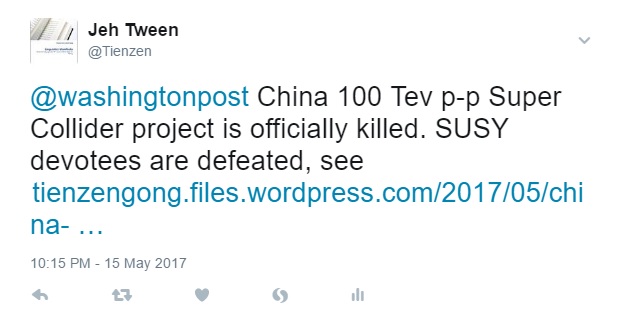Copyright © May 1, 2017 by Tienzen (Jeh-Tween) Gong
{Note: the debate of building China Super Collider (CSC) is now officially over, and CSC project is officially killed. For detailed debate, see China-Super-Collider-analysis (https://tienzengong.files.wordpress.com/2017/05/china-super-collider-analysis.pdf ). For Chinese edition, see China-Super-Collider-debate 2



End Note}
In our previous articles, I have showed two points.
One, there is no new physics for a 100 Tev p-p collider, according to the newest March 2017 data. See China-Super-Collider-part-one
Two, all 3 Nobel Laureates of physics (Steven Weinberg, David Gross, and Sheldon Lee Glashow) did not commit to any prediction that 100 Tev p-p machine can produce any new physics. That is, there is no clear MISSION for this machine.
And, all 3 of them did not try to push USA (their own country) to build such a machine while a tunnel for it is already 100% ready (that is, 70% of the cost is already paid for while the other cost could be shared by other countries). That is, USA will not even waste an idle space for the GREAT project while it is almost free. See China-Super-Collider-part-two
They three are supporting the Chinese project solely on the non-science points. The most important one is the ‘spin-off’ argument, with the example that {CERN invented World Wide Web}. That is, if Chinese Super Collider will not produce any new physics, it still has chance for having some great ‘spin-offs’, perhaps just as great as the WWW.
If this is the key argument for building the Chinese SC, we should then examine whether CERN truly invented WWW or not.
First, what does World Wide Web (WWW) mean for the streetwalking persons? It has two meanings.
One, everyone (streetwalking person) can browse zillions websites.
Two, everyone can publish one’s view and stories online.
With the above definition or understanding, then, what does WWW consist of? What are its backbone parts?
It should have at least (not all inclusive) two parts.
One, everyone has one web device (PC or smart phone) on hand.
Two, these web devices can communicate among one another (download and upload).
So, what is WWW?
Answer: the infrastructure which encompasses the two parts above is a WWW.
Now, we can analyze the parts and the history of this infrastructure.
One, computers must communicate among one another long distance. This was accomplished via internet, invented in 1960s (see https://en.wikipedia.org/wiki/History_of_the_Internet ).
Two, EVERYONE needs a computing device. This possibility starts with the first Apple computer sold by Steve Jobs and Steve Wozniak in 1976. When IBM introduced PC in 1981, the foundation for WWW has set, see https://en.wikipedia.org/wiki/History_of_personal_computers .
Three, without a user friendly computer (usable by every streetwalker), the WWW of today will not be realized. That is, without the introduction of MS window in 1985, PC was not truly usable by everyone, see https://en.wikipedia.org/wiki/History_of_Microsoft_Windows .
Four, without the development of the 32-bit data bus processer {such as the Pentium Pro (a sixth-generation x86 microprocessor) developed and manufactured by Intel, introduced in November 1, 1995, see https://en.wikipedia.org/wiki/Pentium_Pro }, PC was only able to process some text messages, not the kind of web page of today.
Five, without a commercial ISP (Internet service provider), there will be no WWW. The first commercial ISP in the US opened in November 1989, see https://en.wikipedia.org/wiki/The_World_(Internet_service_provider ).
Six, without the communication connection (capable of handling the huge data transmission) among continents, there will be no WWW. The first transatlantic telephone cable to use optical fiber t went into operation in 1988, see https://en.wikipedia.org/wiki/Fiber-optic_communication .
Seven, by 1979, UseNet allowed users to communicate through a virtual newsletter, a text-based web page. While the chat-pages were widely spread in the late 1980s, the modern web pages (with graphs, easily readable by layperson) appeared after the easy using web browser, introduced by Mosaic (later Netscape) in 1993, see https://en.wikipedia.org/wiki/History_of_the_web_browser .
Eight, with many different computing devices, the browsers are having difficult time to read and to display web pages for the different devices; that is, no World Wide pages. In 1995, Java platform (developed by Sun Microsystems which has since been acquired by Oracle Corporation) resolved this issue, see http://www.oracle.com/technetwork/java/javase/overview/javahistory-index-198355.html .
Nine, without a search engine, everyone will be lost in this web site ocean. The first web search engines (Archie search engine, see https://en.wikipedia.org/wiki/Timeline_of_web_search_engines ) appeared in 1990, 4 years before Yahoo and 14 years before Google.
Ten, without the first free social media
https://smallbiztrends.com/2013/05/the-complete-history-of-social-media-infographic.html , not everyone is able to be a publisher; that is, no WWW of today. By 1988, internet relay chats (or IRCs) was already widely used. The first recognizable social media site, Six Degrees, was created in 1997. It enabled users to upload a profile and make friends with other users. In 1999, the first blogging sites became popular, creating a social media sensation that’s still popular today.
After the invention of blogging, social media began to explode in popularity. Sites like MySpace and LinkedIn gained prominence in the early 2000s, and sites like Photobucket and Flickr facilitated online photo sharing. YouTube came out in 2005, creating an entirely new way for people to communicate and share with each other across great distances.
By 2006, Facebook and Twitter both became available to users throughout the world. These sites remain some of the most popular social networks on the Internet.
The above ten are the backbones of WWW. But, where is CERN in this picture? Of course, CERN has absolutely nothing to do with this picture, this infrastructure.
There is only one hyped or dishonest STORY.
Being generating so many documents from so many different departments, CERN commissioned one person (Sir Timothy John Berners-Lee, a computer engineer) to come up a way to handle the communications among departments. Berners-Lee used himself as the hub (a repository) for all documents, the Berners-Lee web site, appeared on 6 August 1991.
Berners-Lee wrote, {Most of the technology involved in the web, like the hypertext, like the Internet, multifont text objects, had all been designed already. I just had to put them together. It was a step of generalizing, going to a higher level of abstraction, thinking about all the documentation systems out there as being possibly part of a larger imaginary documentation system.}
Yes, Berners-Lee was the one who coined the term {World Wide Web} and made some contribution on the HTML language.
But, how dare for him to claim that he invented the WWW while the first commercial ISP was in business in November 1989, while the first web search engine was available in 1990, while the virtual newsletter (a text-based web page) was already in use in 1979, and while Internet relay chats (or IRCs) were widely used in 1988?
As none of the ten above is able to claim the sole credit for WWW, no one challenges Berners-Lee’s dishonest claim. But, how dare for CERN (a big institution) to claim (or not denying) that CERN invented WWW? How dare of those Nobel Laureates to spread this nonsense.
No, WWW is not a spin-off from CERN.
Then, there is another misleading (dishonest) push about the cost of the construction for this China-Super-Collider.
Steven Weinberg and Sheldon Lee Glashow did not talk about this at all. David Gross claimed that the first stage (the CEPC) will cost about 6 billion US dollars while refused to make any speculation about the cost for SPPC.
Yet, the BEPC leadership claims that the total cost (for both CEPC and SPPC) is about 20 billion US dollars. If this is not stupid, must be a lie.
Just check out the cost for LHC.
One, the LHC itself (the first upgrade) costed over 10 billion US dollars.
Two, the LHC used the LEP tunnel. That is, the pre-LHC cost should also be included. The construction of LEP and 15+ years of operation costed over 15 billion US dollars.
Three, the designed LHC life is 25 years. With the current cost (without the future inflation), it is now over one billion dollar a year as the operation cost. The lifetime operation cost will be over 30 billion US dollars.
Four, LHC planed three more upgrades: from 7 to 13 Tev (in 2014); from 13 to 14 Tev (in 2018); then goes to HL-LHC (High Luminosity LHC, in 2020) (http://hilumilhc.web.cern.ch/ ). These three upgrades will cost about 5 billion US dollars.
So, the current estimate for LHC is (15 + 10 + 30 + 5 = 60 billion $), without considering the first 25 billion which could account for as 40 billion of today’s money. And, the next 35 billion could well be under estimated. That is, the cost for LHC (and its upcoming upgrade) will be more than 75 billion US dollars.
But, wait, wait, wait!
CERN itself is unable to process all the data it collects. CERN has a {worldwide LHC computing grid (http://wlcg.web.cern.ch/ )} which is a global collaboration of more than 170 computing centers in 42 countries, linking up national and international grid infrastructures. The operation cost per year for this huge network is over one billion US dollars a year. For 25 years, the cost is over 25 billion today’s dollars.
So, for a 14 Tev machine, the lifetime cost is over 100 billion US dollars.
This brings up another issue. Is this {worldwide LHC computing grid} available for Chinese super collider (CSC) when it begins to run? The answer is almost 100% NO. Is there another computing grid available for CSC? Another big NO for now. That is, China must build her own grid, which will cost at least 10 billion US dollars.
Pushing CSC without any supporting infrastructure, it is evil, trying to do China in. Giving a birth, it costs only 1,000 US dollars, but the lifetime cost for that baby could well go over one million US dollars.
The BEPC leadership is trying to do Chinese people in with their evil ego.
3 thoughts on “China Super Collider, part three — A misled hype or dishonesty”